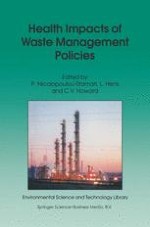2000 | OriginalPaper | Chapter
Impacts of Inadequate or Negligent Waste Disposal on Wildlife and Domestic Animals: Relevance for Human Health
Authors : G. Staats De Yanes, C. V. Howard
Published in: Health Impacts of Waste Management Policies
Publisher: Springer Netherlands
Included in: Professional Book Archive
Activate our intelligent search to find suitable subject content or patents.
Select sections of text to find matching patents with Artificial Intelligence. powered by
Select sections of text to find additional relevant content using AI-assisted search. powered by
Humans are at the top of the food web, and are therefore particularly vulnerable to exposure to those pollutants that are persistent and which bioconcentrate. The major route of human intake of these compounds is food of animal origin. Release and cycling of these compounds in the human food chain is an important problem.Therefore this chapter is intended to give insight into the complex issue of ‘waste as a source for environmental contaminants’, with particular emphasis on the accumulation and effects of environmental contaminants on wildlife and domestic animals and the relevance for human health. Examples and studies related to the release of toxic substances into the environment are reported and accordingly waste sources and types are classified. Additionally a list of substances involved is provided, which represent examples of relevant groups of pollutants.Monitoring the health status and contamination of a wildlife population can be an important tool in early warning systems, in order to protect human health. Effects on wildlife populations, if observed, can point to environmental problems long before effects in humans might be observed. Animal species can be used as indicators for pollution.Waste management and its effects on human health are global problems. This is because of factors such as: global distillation of compounds, the global trade of animal feed, animal products, waste (legal or illegal) and, last but not least, global tourism. Therefore this is a problem that cannot be solved solely on a national basis but only by an international co-operation in identifying sources, decreasing or stopping emissions and developing strategies to avoid the intake of hazardous amounts of contaminants.In conclusion, strategies for the avoidance of the release into the environment are discussed. Recent developments in the contamination of animal feeds in Europe, which have been widely spread throughout the food distribution system, act to highlight the unfortunate consequences that can arise from using the food chain as a sink for industrial waste.
